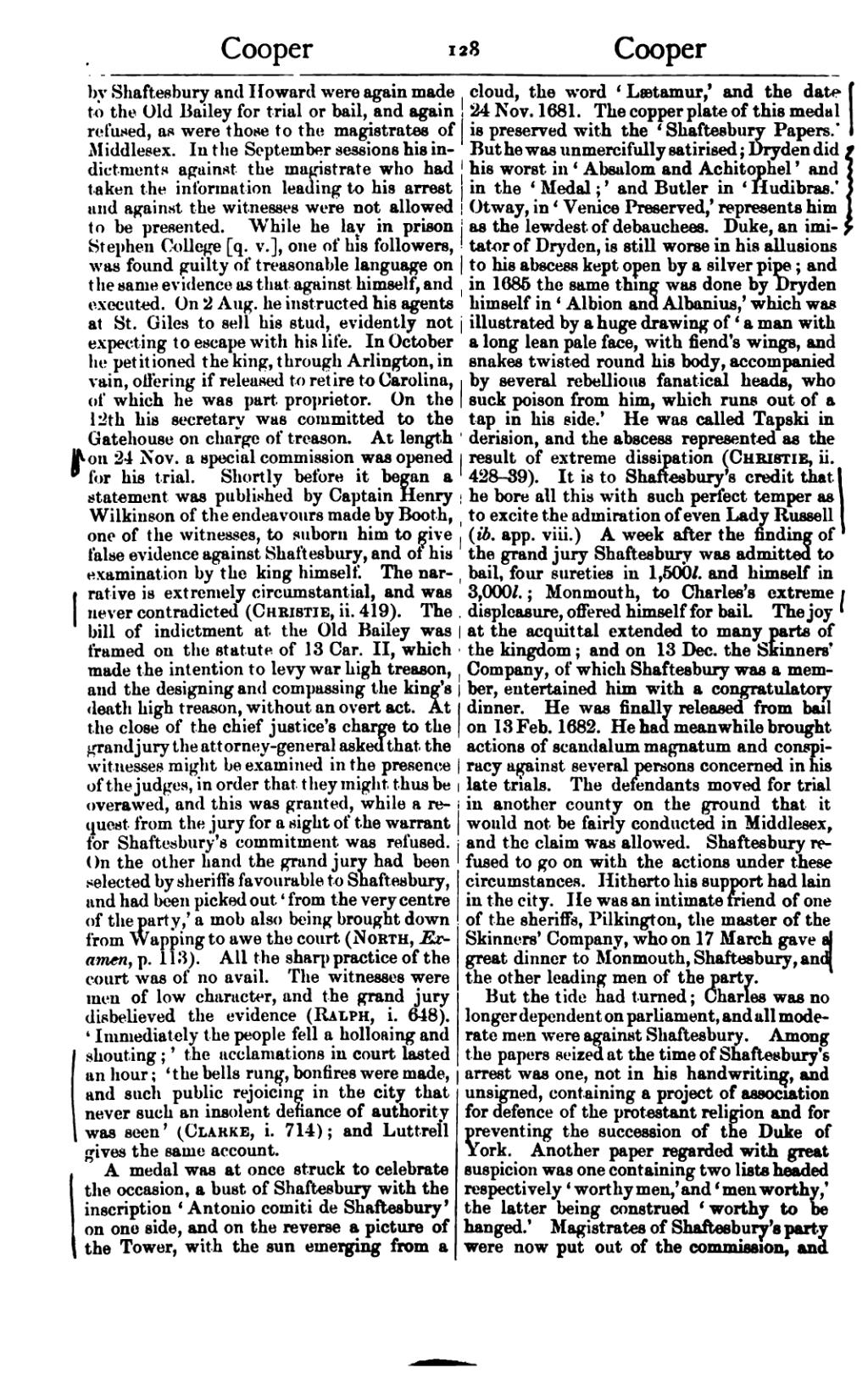by Shaftesbury and Howard were again made to the Old Bailey for trial or bail, and again refused, as were those to the magistrates of Middlesex. In the September sessions his indictments against the magistrate who had taken the information leading to his arrest and against the witnesses were not allowed to be presented. While he lay in prison Stephen College [q. v.], one of his followers, was found guilty of treasonable language on the same evidence as that against himself, and executed. On 2 Aug. he instructed his agents at St. Giles to sell his stud, evidently not expecting to escape with his life. In October he petitioned the king, through Arlington, in vain, offering if released to retire to Carolina, of which he was part proprietor. On the 12th his secretary was committed to the Gatehouse on charge of treason. At length on 24 Nov. a special commission was opened for his trial. Shortly before it began a statement was published by Captain Henry Wilkinson of the endeavours made by Booth, one of the witnesses, to suborn him to give false evidence against Shaftesbury, and of his examination by the king himself. The narrative is extremely circumstantial, and was never contradicted (Christie, ii. 149). The bill of indictment at the Old Bailey was framed on the statute of 13 Car. II, which made the intention to levy war high treason, and the designing and compassing the king's death high treason, without an overt act. At the close of the chief justice's charge to the grand jury the attorney-general asked that the witnesses might be examined in the presence of the judges, in order that they might thus be overawed, and this was granted, while a request from the jury for a sight of the warrant for Shaftesbury's commitment was refused. On the other hand the grand jury had been selected by sheriffs favourable to Shaftesbury, and had been picked out ‘from the very centre of the party,’ a mob also being brought down from Wapping to awe the court (North, Examen, p. 113). All the sharp practice of the court was of no avail. The witnesses were men of low character, and the grand jury disbelieved the evidence (Ralph, i. 648). ‘Immediately the people fell a holloaing and shouting;’ the acclamations in court lasted an hour; ‘the bells rung, bonfires were made, and such public rejoicing in the city that never such an insolent defiance of authority was seen’ (Clarke, i. 714); and Luttrell gives the same account.
A medal was at once struck to celebrate the occasion, a bust of Shaftesbury with the inscription ‘Antonio comiti de Shaftesbury’ on one side, and on the reverse a picture of the Tower, with the sun emerging from a cloud, the word ‘Lætamur,’ and the date 24 Nov. 1681. The copper plate of this medal is preserved with the ‘Shaftesbury Papers.’ But he was unmercifully satirised; Dryden did his worst in ‘Absalom and Achitophel’ and in the ‘Medal;’ and Butler in ‘Hudibras.’ Otway, in ‘Venice Preserved,’ represents him as the lewdest of debauchees. Duke, an imitator of Dryden, is still worse in his allusions to his abscess kept open by a silver pipe; and in 1685 the same thing was done by Dryden himself in ‘Albion and Albanius,’ which was illustrated by a huge drawing of ‘a man with a long lean pale face, with fiend's wings, and snakes twisted round his body, accompanied by several rebellious fanatical heads, who suck poison from him, which runs out of a tap in his side.’ He was called Tapski in derision, and the abscess represented as the result of extreme dissipation (Christie, ii. 428–39). It is to Shaftesbury's credit that he bore all this with such perfect temper as to excite the admiration of even Lady Russell (ib. app. viii.) A week after the finding of the grand jury Shaftesbury was admitted to bail, four sureties in 1,500l. and himself in 3,000l.; Monmouth, to Charles's extreme displeasure, offered himself for bail. The joy at the acquittal extended to many parts of the kingdom; and on 13 Dec. the Skinners' Company, of which Shaftesbury was a member, entertained him with a congratulatory dinner. He was finally released from bail on 13 Feb. 1682. He had meanwhile brought actions of scandalum magnatum and conspiracy against several persons concerned in his late trials. The defendants moved for trial in another county on the ground that it would not be fairly conducted in Middlesex, and the claim was allowed. Shaftesbury refused to go on with the actions under these circumstances. Hitherto his support had lain in the city. He was an intimate friend of one of the sheriffs, Pilkington, the master of the Skinners' Company, who on 17 March gave a great dinner to Monmouth, Shaftesbury, and the other leading men of the party.
But the tide had turned; Charles was no longer dependent on parliament, and all moderate men were against Shaftesbury. Among the papers seized at the time of Shaftesbury's arrest was one, not in his handwriting, and unsigned, containing a project of association for defence of the protestant religion and for preventing the succession of the Duke of York. Another paper regarded with great suspicion was one containing two lists headed respectively ‘worthy men,’ and ‘men worthy,’ the latter being construed ‘worthy to be hanged.’ Magistrates of Shaftesbury's party were now put out of the commission, and
